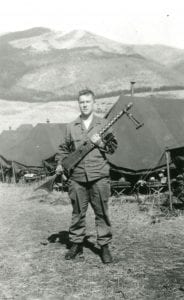By Russell Horton, Reference & Outreach Archivist
“I’ve got documents that I brought out of Korea… just pieces of paper with numbers on them. They are very old. These numbers all mean something.” – Darrell Krenz, WVM Oral History Interview

2 3 1 6 8 0 1 5. The first two digits are random “dummy” numbers, meant to confuse anyone trying to break the code. The third and fourth digits—1 and 6—represent K, the sixteenth letter in the alphabet when counting from the end and the first letter of a surname. The fifth digit is another random “dummy” number, while the sixth and seventh—0 and 1—represent Z, the first letter in the alphabet when counting from the end and the last letter of a surname. The last digit—5—represents the total number of letters in a surname. In this example, the numbers mean KRENZ.
Numbers played an important role in the story of Darrell Krenz’s Korean War service. The Columbus, Wisconsin native enlisted into the Army on 1/18/1949 at the age of 17. Initially training with the 101st Airborne in Kentucky, he asked to serve overseas and was transferred to Company L, 34th Infantry Regiment, 24th Infantry Division in Japan in April 1949. That Division was the first American unit sent into Korea in July 1950 to delay the North Korean advance until more American troops arrived.

On 7/20/1950, during the Battle of Taejon, a wounded Krenz and roughly 700 other American soldiers were taken prisoner and endured a brutal forced march, called the Tiger Death March, north to Chungganjin prison camp, near the Chinese border. There, Krenz was caught stealing some hot peppers from a kitchen and was severely beaten and forced to eat the whole peppers. Less than 300 of the prisoners remained alive when they were given over to Chinese custody in October 1951. At Chinese Camp #3, Krenz left his assigned area to share Christmas greetings with a fellow prisoner in December 1952 and was punished by being forced to stand outside in the harsh winter weather with no shirt or shoes.
While in Chinese Camp #3, numbers became even more important to Krenz. Along with several other Americans prisoners, he began to record various happenings in the camp, particularly instances of American prisoners cooperating or aiding their Chinese captors. Krenz recorded the names of these men on small strips of cigarette paper using the 8 digit numerical system described above. In order to hide the papers from the prison guards, Krenz wrapped the tiny strips in blotting paper and stored them in his mouth.
In August 1953, after more than 1,100 days as a prisoner of war, Darrell Krenz returned to United States’ custody as part of Operation Big Switch. Dept. of Defense officials, very concerned about the “brainwashing” techniques used by the Chinese and the overall treatment of American prisoners by Korea and China, thoroughly interviewed Krenz on several occasions. They compiled a large file on him that included transcripts of his detailed descriptions of the numerical code and what it meant, along with the full story of his prisoner of war experience.
Almost 50 years later, Krenz participated in the WVM Oral History project, sharing the story of his entire military service including his prisoner of war experience and his numerical code, stating “all these numbers mean something.” He also donated the actual scraps of coded cigarette paper to the WVM archives, along with copies of his declassified Dept. of Defense files. Thus researchers today and generations from now will be able to see the code itself, read Krenz’s description of it from immediately after his release in the Dept. of Defense files, and then hear Krenz’s description of it in the oral history interview conducted half a century afterward. Together, these materials represent an incredibly important resource for learning about the POW experience in the Korean War while, just as importantly, they also acknowledge the brave and faithful service of a Wisconsin veteran.

